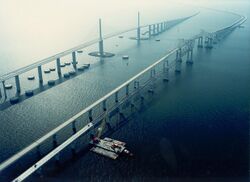Dolphin (structure)
Topic: Engineering
 From HandWiki - Reading time: 3 min
From HandWiki - Reading time: 3 min
A dolphin is a group of pilings arrayed together to serve variously as a protective hardpoint along a dock, in a waterway, or along a shore; as a means or point of stabilization of a dock, bridge, or similar structure; as a mooring point; and as a base for navigational aids.
Structure
Dolphins typically consist of a number of piles driven into the seabed or riverbed, and connected above the water level to provide a platform or fixing point. The piles can be untreated or pressure-treated timber piles, or steel or reinforced concrete piles. Smaller dolphins can have the piles drawn together with wire rope, but larger dolphins are typically fixed using a reinforced concrete capping or a structural steel frame.
Access to a dolphin may be via a pedestrian bridge, particularly in the case of mooring dolphins, but is often by boat.
Use
As mooring point
Dolphins are usually installed to provide a fixed structure when it would be impractical to extend the shore to provide a dry-access facility, for example, when the number of ships is greater than can be accommodated by the length of the berth/pier.[1] Typical uses include extending a berth (a berthing dolphin) or providing a mooringpoint (a mooring dolphin).
To protect structures
Dolphins are also used to protect structures from possible impact by ships, in a similar fashion to boating fenders.[2] A notable example of dolphins used to protect a bridge is the Sunshine Skyway Bridge across the mouth of Tampa Bay. In 1980, the MV Summit Venture hit a pier on one of the bridge's two, two-lane spans causing a 1,200-foot (370 m) section of the bridge to fall into the water, resulting in 35 deaths. When a replacement span was designed, a top priority was to prevent ships from colliding with the new bridge.[3] The new bridge is protected by 36 dolphins: four large dolphins protecting the two main pylons supporting the cable-stayed main span plus 32 smaller dolphins protecting bridge piers for 1⁄4 mi (1⁄2 km) to either side of the main span.[3] The cost of the dolphins was $41 million (approximately $90 million in 2017 dollars).[3]
Dolphins are also used to house navigation aids such as lights or daybeacons, and display regulatory information such as speed limits and other safety information, or advertising.
See also
- Starling (structure) - a protective base for bridge piers
References
- ↑ Tsinker, Gregory P. (February 16, 2004). Port engineering: planning, construction, maintenance, and security. John Wiley & Sons. pp. 474. ISBN 9780471412748. https://books.google.com/books?id=kXaAKdwyJzYC&q=%22mooring+dolphins+are%22&pg=PA474.
- ↑ "Robert Cabral, Plaintiff-appellant, v. Healy Tibbits Builders, Inc., Defendant-appellee United States Court of Appeals, Ninth Circuit. - 128 F.3d 1289". October 15, 1997. http://cases.justia.com/us-court-of-appeals/F3/128/1289/525073/. Retrieved November 30, 2010.
- ↑ 3.0 3.1 3.2 Scherberger, Tom (March 22, 1987). "The Lesson - A Bridge On Guard Span's Protective Shield Called Best In The World". The Orlando Sentinel. http://articles.orlandosentinel.com/1987-03-22/news/0120010006_1_bridge-was-completed-skyway-piers. Retrieved April 29, 2018.
 |
 KSF
KSF

